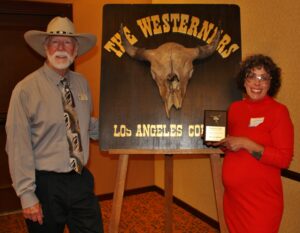Roundup: August 10 2022
august2022
Roundup Synopsis
Taken From Branding Iron 307 Summer 2022.
In August, the Westerners welcomed Jillian Moore to the Corral. The Wyoming native, and Ph.D. candidate in English at Duquesne University, spoke of subjects related to her forthcoming dissertation. Her talk, entitled “Selling the Image of ‘The West’: Frontier Economies,” challenged us to take stock of what we enjoy about the American West, to ponder the reasons for our interest, and to take care to be appreciative of the history and culture of its Native inhabitants, rather than appropriative. Speaking on such topics in front of a body founded almost solely on appreciation of the West posed some danger, but Ms. Moore rather deftly navigated those choppy waters to enlighten where others may have admonished. If we were to distill the thesis of her discussion into a single phrase, perhaps the most apt would be, “Give credit where credit is due.”
Perhaps the most impactful section of the presentation featured a historic, Blackfoot-made capote, juxtaposed against a modern, Native-”inspired” coat from the Pendleton company. Ms. Moore highlighted the specific elements of the historic garment, illustrating its connection to a specific time, place, and ethnic group. No such specificity was present in the Pendleton coat, as it was simply a mishmash of Native-like designs in a stereotypically Southwestern color scheme. This comparison served to drive home the point that we should be wary of objects and ideas formed from disparate bits of the art and history of marginalized groups, like America’s indigenous communities, and forcing them through a cultural meat-grinder to arrive at something more readily digestible to consumers unfamiliar with the originals.
In the question-and-answer section following the main presentation, Ms. Moore reiterated that the intention of efforts to mitigate this type of co-option is not to demonize those who occasionally stray from appreciation into appropriation (“Let he who is without sin,” etc.), but rather to properly attribute artifacts and ideas to the cultures that bore them. Most scholars would never use a source in their research without citing it. The same thinking could be applied to consumers in the context of the art and artifacts of our indigenous neighbors. It is possible, and likely preferable, to spend our money on goods made by the people whose culture such products represent. Or, at the very least, we can give credit where credit is due.
— Alan Griffin
Speaker Jillian Moore and Sheriff Pete Fries




